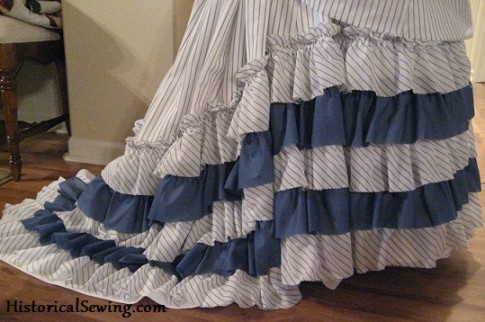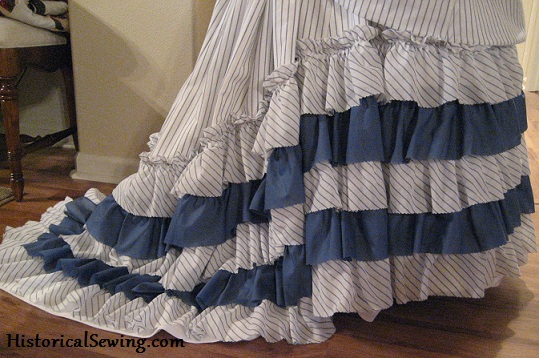
Ruffles are SO Victorian! You see them on so many skirts from the 1830s all the way through the early 1880s.
But how do you figure how much fabric you’ll need for these fluffy strips of trim? 1 yard? 5 yards?
Here is the easy formula for you…
These calculations are for cutting your fabric in strips across the width (on the cross grain). For bias cut ruffles, well.. you’ll need a bit more fabric than what you figure here depending on how wide those ruffles will be.
Information you need to collect (the numbers here are for example only):
- Measurement of finished skirt hem: 122″ (this is after the seams are sewn, or before sewing, take out the seam allowances when measuring your pattern)
- Number of ruffles you want: 3
- Finished width of ruffles: 5″
- Usable width of your fabric: 41″ (that’s without the selvedges)
First figure the cut width of your ruffles:
Finished width plus hem and seam allowances. I’ll be sewing these ruffles on 1/2″ below the top edge but I’ll still need to hem that top edge or have allowance enough to fold the seam allowance under the ruffle.
5″ + 1/2″ hem + 1/2″ at top of ruffle = 6″ cut width
If you want a header on your ruffle, you’ll need to figure this in here to get your cut width.
Next figure how much total length you’ll need to cover the skirt:
We have 3 rows each sewn on a 122″ skirt. (It makes sense that the higher you place a ruffle the skirt may also be more narrow. However, it’s just easier to do this calculation based on the full hem length.)
3 x 122″ = 366″
This is the flat measurement so we’ll have to add for gathering. Most 19th Century ruffles are lightly gathered between 1.25 and 1.75 times. You can do 2 times the length in gathering but it starts to be too much for a period look. For this example we’ll use 1.5 times.
366″ x 1.5 = 549″
This 549″ is the total length of our cut ruffles – the strip length you need to make the three rows.
Then figure how many fabric strips to cut:
Take your total ruffle cut length and divide by the usable width of your fabric, which here is 41″.
549″ / 41″ = 13.4
Many times you’ll end up with an odd amount. Always round UP to the nearest half. For this example, we’ll cut 13 and a half strips of the fabric, or rather 14 strips.
Each strip will be cut at 6″.
Finally, calculate the yardage needed:
You’re now going to multiply how many strips you need to cut by the cut width. Then you’ll divide that number by 36″ which is the length of a yard.
14 strips x 6″ cut width = 84″
84″ / 36″ (yard) = 2.3 yards
This calculates that we need 2.3 yards of fabric at 41″ usable width to make our 3 rows of ruffles.
SPECIAL NOTE: this is the minimum yardage you need. Be smart and get more length – I’d go with a full 3 yards to allow for straightening the raw edges and the grain (if needed). Also, when you cut strips, somehow after several cuts you’ll start to notice you’re not cutting exactly on grain anymore. Trim the edge to get you back on track.
Use these calculations to figure any width of ruffle you want, and any number of ruffles you need.
After you cut your ruffles, relax when you go to sew them on.
If you are wanting to make pleated ruffles, you might want to read this post for help.
Now go… make lots of ruffled skirts!


I’ve read so many of these tutorials and posts my head is spinning. lol I understand the ruffles and how to measure, cut and sew them but what about the base? What shape is the base?
😀 Now THAT question is answered specific to your project and what you’re sewing the ruffles TO. Is it a petticoat with straight panels? Is it a shaped skirt, cut in gored panels made in fashion fabric worn over a mid-19th century hoop? Is it the hem of a shaped bell sleeve of the 1870s?
For the skirt shown in this post, I used the Truly Victorian TV208 trained skirt as my base in plain, sturdy cotton. The ruffles in two different sheer cotton fabrics were mounted on top.
good morning!
you wrote: “You can do 2 times the length in gathering but it starts to be too much for a period look.” I want a summer chiffon (40 Grs / Ml) 2-tier 1850’s bal dress. How many times the length in gathering should I use?
Thank you again for your amazing work and your patience
For sheers you could go as low as 1.5 times the length for gathering and up to 2.5 times for more dense gathers. A fluffy 1850s skirt can go with more gathers, especially being a ball gown.
Thank you for your advice. I will do my maths with 2 times : less expensive (fabric, trimming) less Time consuming than 2.5 times but probably looks “Richer” than 1.5..
Best regards
You’ll be fine with 2x. And yes, definitely less fabric needed. But also use it as a learning opportunity so you see how sheer fabric acts with a double length and how you can add or use less in your next project. 🙂
Thank you! I needed to add ruffles to my apron but had no clue as to how to add for gathering measurements.
Cheers
Thank you for posting. I get distracted when doing that in my head.
Excellent explanation, along with the historical information (how much density of ruffle for the period) & mathematics for figuring out length & width.
I usually tear my fabric when it is on the grain. That way I don’t have to worry so much about my inaccuracies in cutting. It usually works pretty well.
This is a GREAT tutorial…very well explained for the novice to be able to follow along…